Motivation Theories: Hawthorne Studies vs. Theory X and Theory Y
VerifiedAdded on 2023/06/16
|10
|2703
|252
Essay
AI Summary
This essay provides an analysis of Elton Mayo's Hawthorne studies, focusing on the impact of workplace lighting and social factors on employee productivity and motivation. It discusses the Hawthorne effect and Mayo's theory of motivation, highlighting the importance of positive relational factors and team dynamics. Additionally, the essay contrasts Douglas McGregor's Theory X and Theory Y, outlining their opposing views on human behavior in the workplace. It examines the assumptions of each theory and their implications for modern management, particularly in terms of employee motivation, control, and decision-making. The essay concludes by emphasizing the relevance of these theories in shaping management practices and fostering a positive and productive work environment. Desklib offers additional resources and solved assignments for students studying management and organizational behavior.
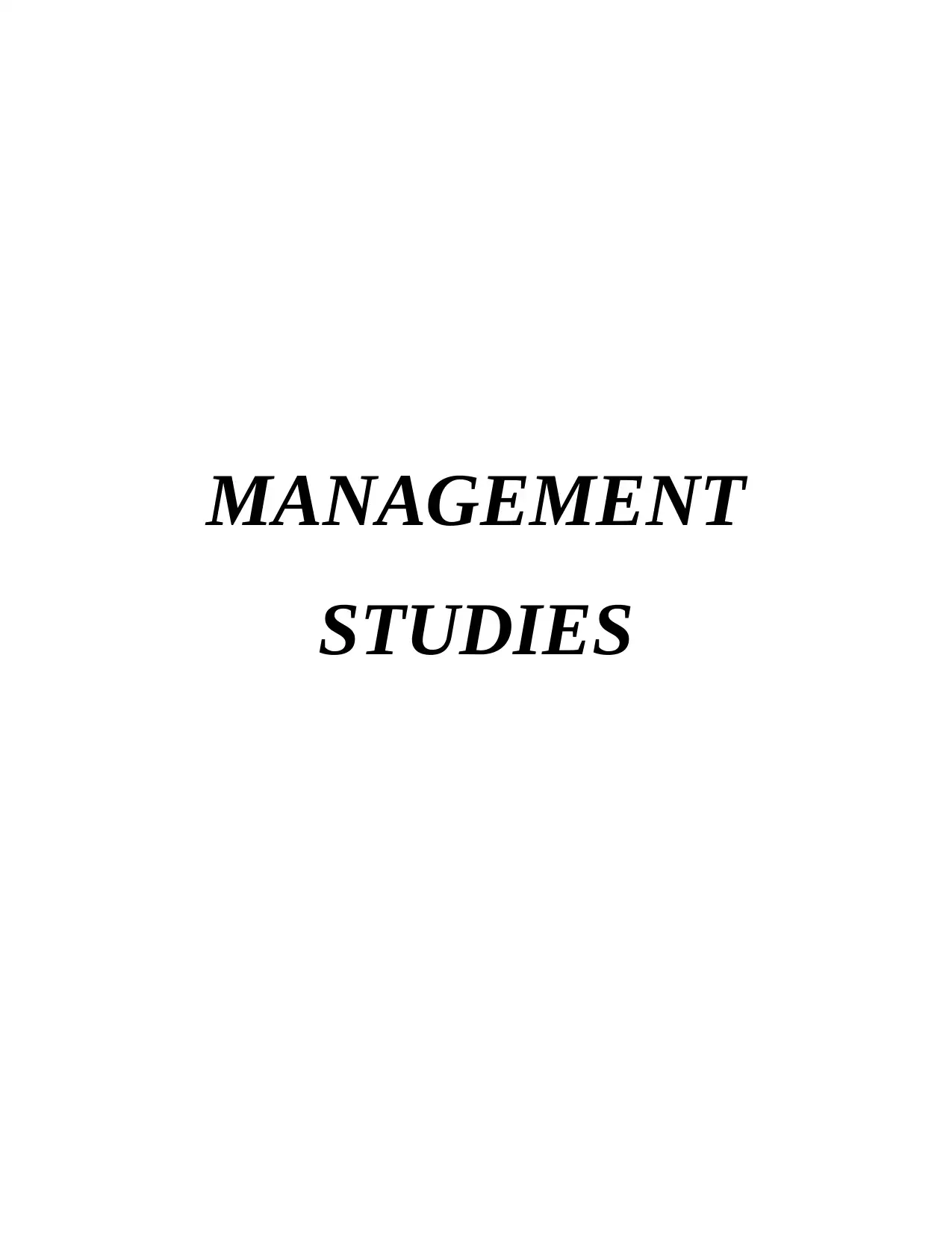
MANAGEMENT
STUDIES
STUDIES
Paraphrase This Document
Need a fresh take? Get an instant paraphrase of this document with our AI Paraphraser
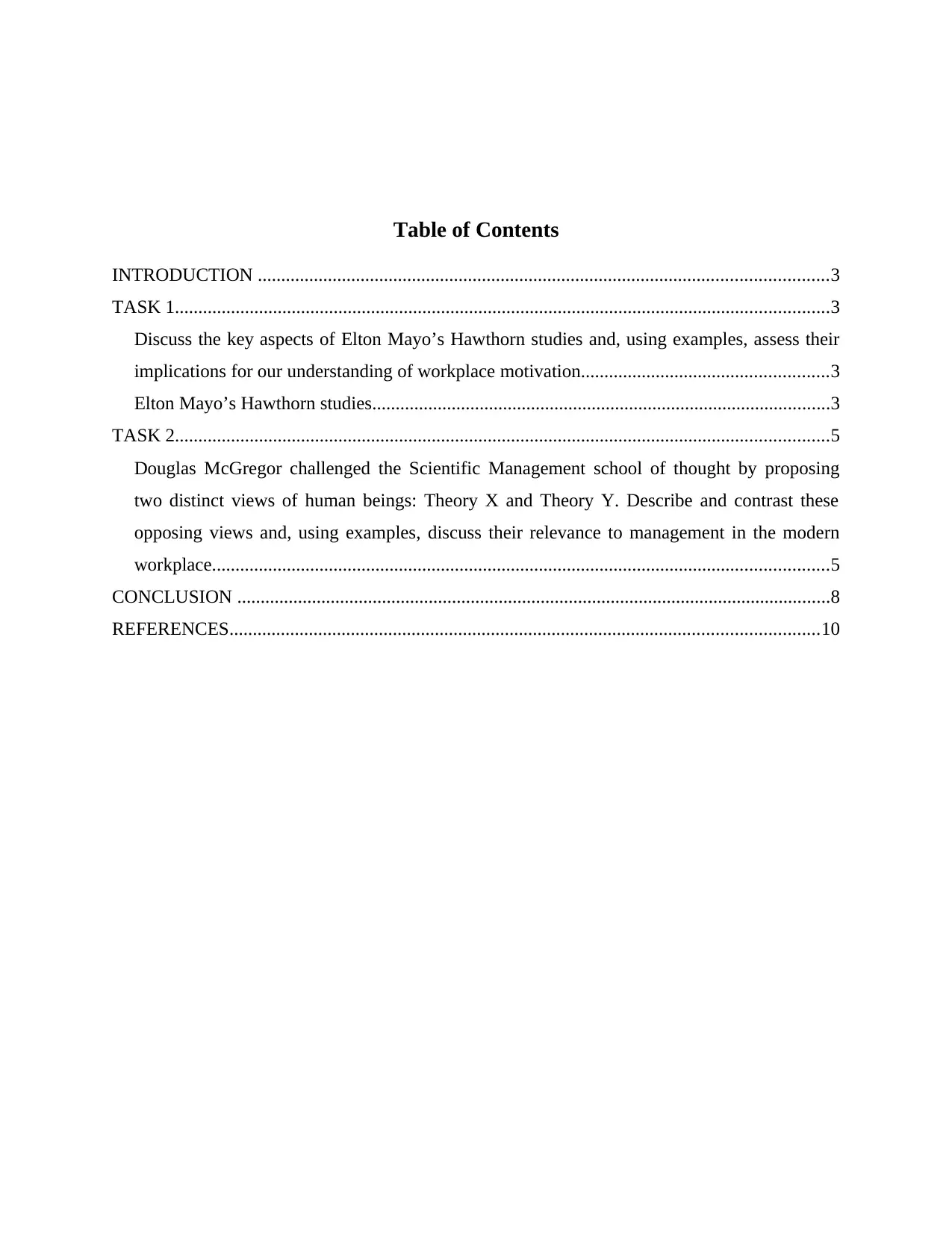
Table of Contents
INTRODUCTION ..........................................................................................................................3
TASK 1............................................................................................................................................3
Discuss the key aspects of Elton Mayo’s Hawthorn studies and, using examples, assess their
implications for our understanding of workplace motivation.....................................................3
Elton Mayo’s Hawthorn studies..................................................................................................3
TASK 2............................................................................................................................................5
Douglas McGregor challenged the Scientific Management school of thought by proposing
two distinct views of human beings: Theory X and Theory Y. Describe and contrast these
opposing views and, using examples, discuss their relevance to management in the modern
workplace....................................................................................................................................5
CONCLUSION ...............................................................................................................................8
REFERENCES..............................................................................................................................10
INTRODUCTION ..........................................................................................................................3
TASK 1............................................................................................................................................3
Discuss the key aspects of Elton Mayo’s Hawthorn studies and, using examples, assess their
implications for our understanding of workplace motivation.....................................................3
Elton Mayo’s Hawthorn studies..................................................................................................3
TASK 2............................................................................................................................................5
Douglas McGregor challenged the Scientific Management school of thought by proposing
two distinct views of human beings: Theory X and Theory Y. Describe and contrast these
opposing views and, using examples, discuss their relevance to management in the modern
workplace....................................................................................................................................5
CONCLUSION ...............................................................................................................................8
REFERENCES..............................................................................................................................10
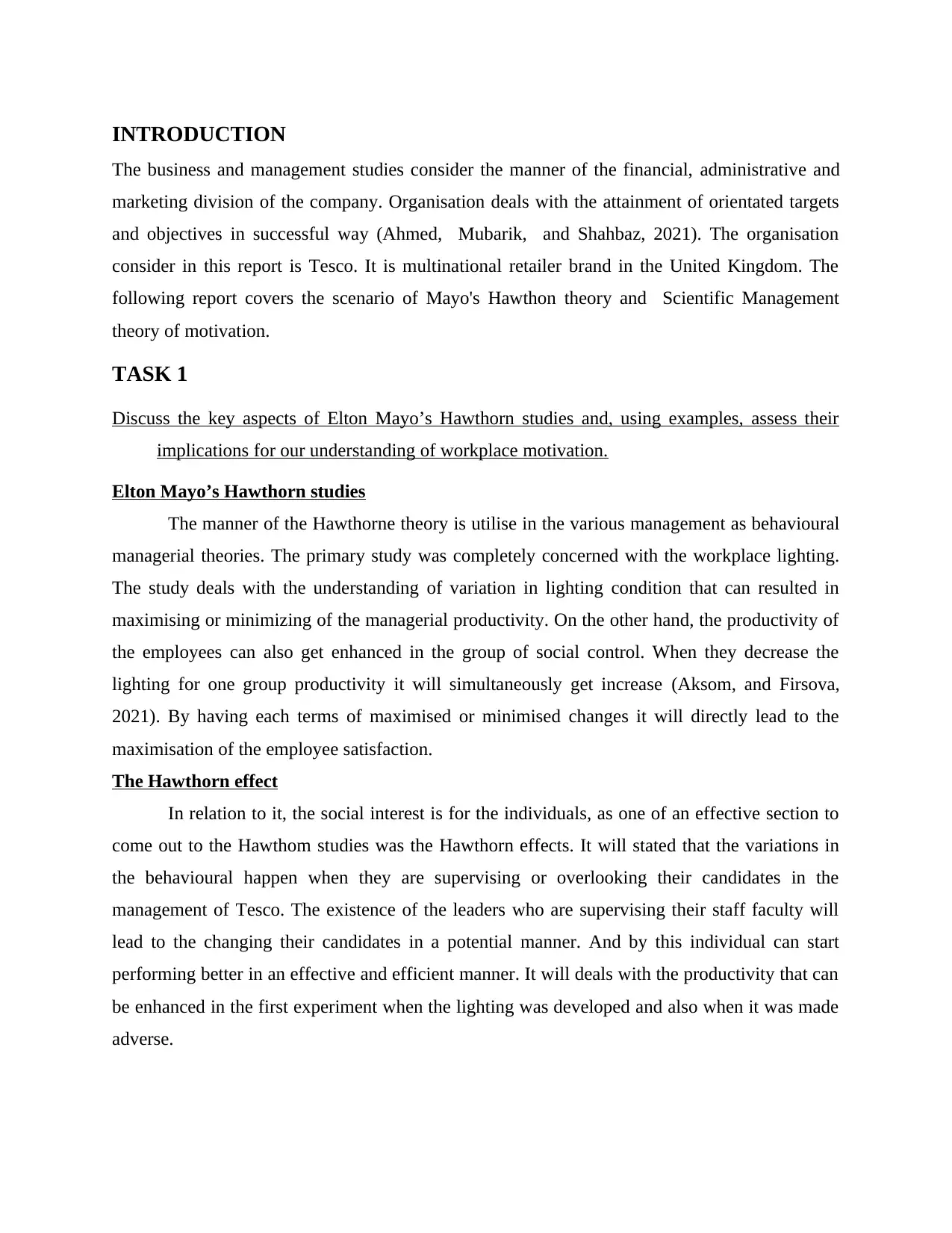
INTRODUCTION
The business and management studies consider the manner of the financial, administrative and
marketing division of the company. Organisation deals with the attainment of orientated targets
and objectives in successful way (Ahmed, Mubarik, and Shahbaz, 2021). The organisation
consider in this report is Tesco. It is multinational retailer brand in the United Kingdom. The
following report covers the scenario of Mayo's Hawthon theory and Scientific Management
theory of motivation.
TASK 1
Discuss the key aspects of Elton Mayo’s Hawthorn studies and, using examples, assess their
implications for our understanding of workplace motivation.
Elton Mayo’s Hawthorn studies
The manner of the Hawthorne theory is utilise in the various management as behavioural
managerial theories. The primary study was completely concerned with the workplace lighting.
The study deals with the understanding of variation in lighting condition that can resulted in
maximising or minimizing of the managerial productivity. On the other hand, the productivity of
the employees can also get enhanced in the group of social control. When they decrease the
lighting for one group productivity it will simultaneously get increase (Aksom, and Firsova,
2021). By having each terms of maximised or minimised changes it will directly lead to the
maximisation of the employee satisfaction.
The Hawthorn effect
In relation to it, the social interest is for the individuals, as one of an effective section to
come out to the Hawthom studies was the Hawthorn effects. It will stated that the variations in
the behavioural happen when they are supervising or overlooking their candidates in the
management of Tesco. The existence of the leaders who are supervising their staff faculty will
lead to the changing their candidates in a potential manner. And by this individual can start
performing better in an effective and efficient manner. It will deals with the productivity that can
be enhanced in the first experiment when the lighting was developed and also when it was made
adverse.
The business and management studies consider the manner of the financial, administrative and
marketing division of the company. Organisation deals with the attainment of orientated targets
and objectives in successful way (Ahmed, Mubarik, and Shahbaz, 2021). The organisation
consider in this report is Tesco. It is multinational retailer brand in the United Kingdom. The
following report covers the scenario of Mayo's Hawthon theory and Scientific Management
theory of motivation.
TASK 1
Discuss the key aspects of Elton Mayo’s Hawthorn studies and, using examples, assess their
implications for our understanding of workplace motivation.
Elton Mayo’s Hawthorn studies
The manner of the Hawthorne theory is utilise in the various management as behavioural
managerial theories. The primary study was completely concerned with the workplace lighting.
The study deals with the understanding of variation in lighting condition that can resulted in
maximising or minimizing of the managerial productivity. On the other hand, the productivity of
the employees can also get enhanced in the group of social control. When they decrease the
lighting for one group productivity it will simultaneously get increase (Aksom, and Firsova,
2021). By having each terms of maximised or minimised changes it will directly lead to the
maximisation of the employee satisfaction.
The Hawthorn effect
In relation to it, the social interest is for the individuals, as one of an effective section to
come out to the Hawthom studies was the Hawthorn effects. It will stated that the variations in
the behavioural happen when they are supervising or overlooking their candidates in the
management of Tesco. The existence of the leaders who are supervising their staff faculty will
lead to the changing their candidates in a potential manner. And by this individual can start
performing better in an effective and efficient manner. It will deals with the productivity that can
be enhanced in the first experiment when the lighting was developed and also when it was made
adverse.
⊘ This is a preview!⊘
Do you want full access?
Subscribe today to unlock all pages.

Trusted by 1+ million students worldwide
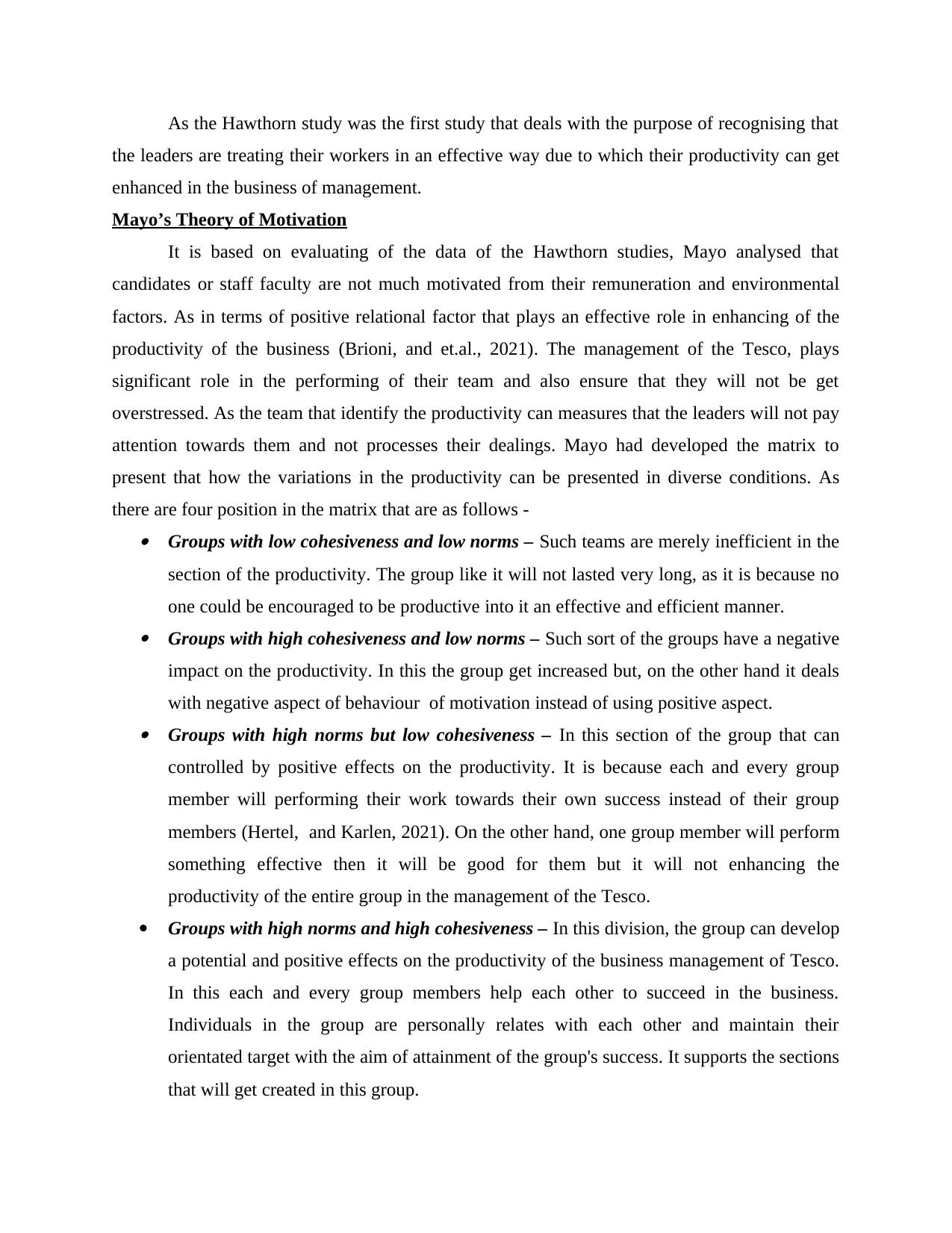
As the Hawthorn study was the first study that deals with the purpose of recognising that
the leaders are treating their workers in an effective way due to which their productivity can get
enhanced in the business of management.
Mayo’s Theory of Motivation
It is based on evaluating of the data of the Hawthorn studies, Mayo analysed that
candidates or staff faculty are not much motivated from their remuneration and environmental
factors. As in terms of positive relational factor that plays an effective role in enhancing of the
productivity of the business (Brioni, and et.al., 2021). The management of the Tesco, plays
significant role in the performing of their team and also ensure that they will not be get
overstressed. As the team that identify the productivity can measures that the leaders will not pay
attention towards them and not processes their dealings. Mayo had developed the matrix to
present that how the variations in the productivity can be presented in diverse conditions. As
there are four position in the matrix that are as follows - Groups with low cohesiveness and low norms – Such teams are merely inefficient in the
section of the productivity. The group like it will not lasted very long, as it is because no
one could be encouraged to be productive into it an effective and efficient manner. Groups with high cohesiveness and low norms – Such sort of the groups have a negative
impact on the productivity. In this the group get increased but, on the other hand it deals
with negative aspect of behaviour of motivation instead of using positive aspect. Groups with high norms but low cohesiveness – In this section of the group that can
controlled by positive effects on the productivity. It is because each and every group
member will performing their work towards their own success instead of their group
members (Hertel, and Karlen, 2021). On the other hand, one group member will perform
something effective then it will be good for them but it will not enhancing the
productivity of the entire group in the management of the Tesco.
Groups with high norms and high cohesiveness – In this division, the group can develop
a potential and positive effects on the productivity of the business management of Tesco.
In this each and every group members help each other to succeed in the business.
Individuals in the group are personally relates with each other and maintain their
orientated target with the aim of attainment of the group's success. It supports the sections
that will get created in this group.
the leaders are treating their workers in an effective way due to which their productivity can get
enhanced in the business of management.
Mayo’s Theory of Motivation
It is based on evaluating of the data of the Hawthorn studies, Mayo analysed that
candidates or staff faculty are not much motivated from their remuneration and environmental
factors. As in terms of positive relational factor that plays an effective role in enhancing of the
productivity of the business (Brioni, and et.al., 2021). The management of the Tesco, plays
significant role in the performing of their team and also ensure that they will not be get
overstressed. As the team that identify the productivity can measures that the leaders will not pay
attention towards them and not processes their dealings. Mayo had developed the matrix to
present that how the variations in the productivity can be presented in diverse conditions. As
there are four position in the matrix that are as follows - Groups with low cohesiveness and low norms – Such teams are merely inefficient in the
section of the productivity. The group like it will not lasted very long, as it is because no
one could be encouraged to be productive into it an effective and efficient manner. Groups with high cohesiveness and low norms – Such sort of the groups have a negative
impact on the productivity. In this the group get increased but, on the other hand it deals
with negative aspect of behaviour of motivation instead of using positive aspect. Groups with high norms but low cohesiveness – In this section of the group that can
controlled by positive effects on the productivity. It is because each and every group
member will performing their work towards their own success instead of their group
members (Hertel, and Karlen, 2021). On the other hand, one group member will perform
something effective then it will be good for them but it will not enhancing the
productivity of the entire group in the management of the Tesco.
Groups with high norms and high cohesiveness – In this division, the group can develop
a potential and positive effects on the productivity of the business management of Tesco.
In this each and every group members help each other to succeed in the business.
Individuals in the group are personally relates with each other and maintain their
orientated target with the aim of attainment of the group's success. It supports the sections
that will get created in this group.
Paraphrase This Document
Need a fresh take? Get an instant paraphrase of this document with our AI Paraphraser
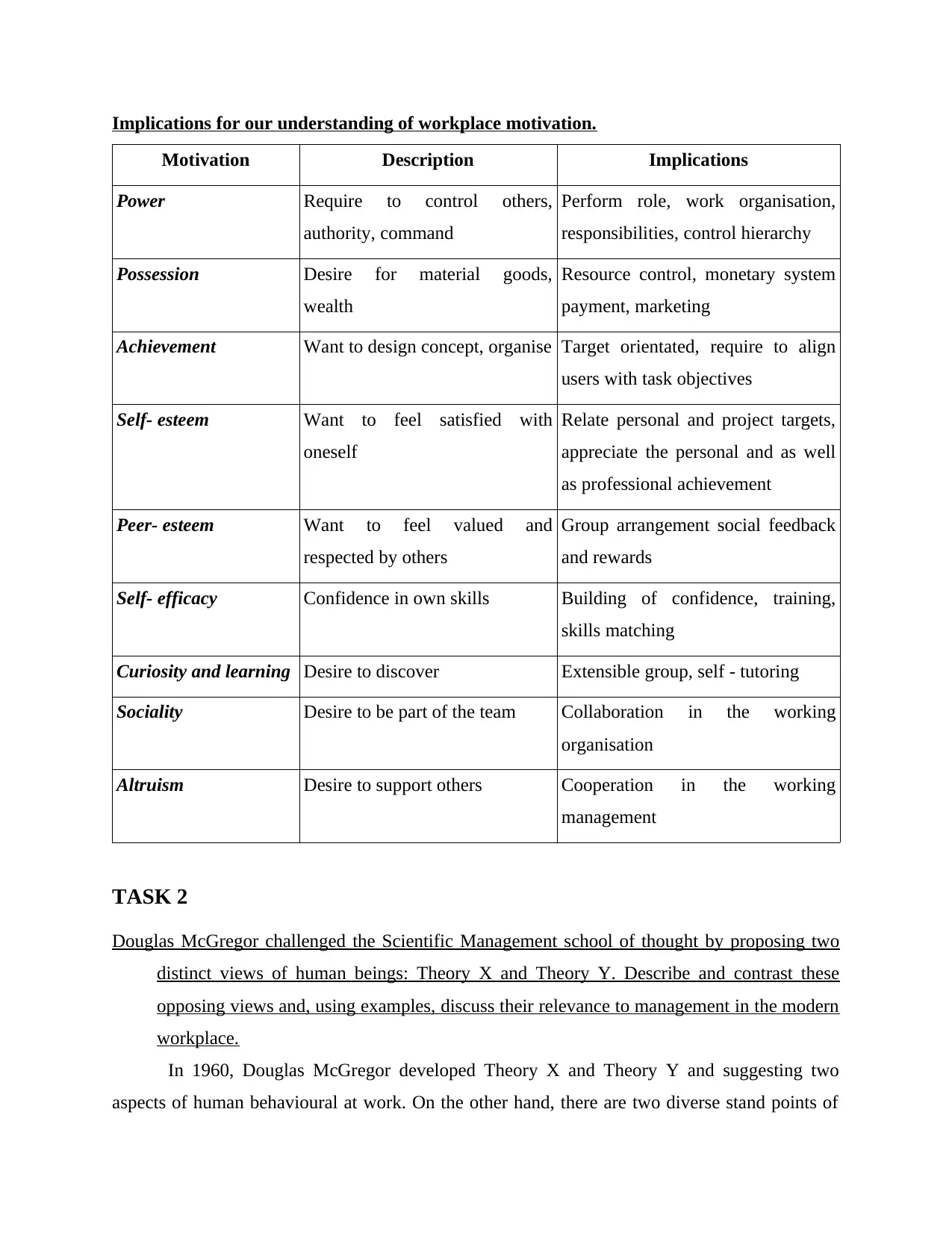
Implications for our understanding of workplace motivation.
Motivation Description Implications
Power Require to control others,
authority, command
Perform role, work organisation,
responsibilities, control hierarchy
Possession Desire for material goods,
wealth
Resource control, monetary system
payment, marketing
Achievement Want to design concept, organise Target orientated, require to align
users with task objectives
Self- esteem Want to feel satisfied with
oneself
Relate personal and project targets,
appreciate the personal and as well
as professional achievement
Peer- esteem Want to feel valued and
respected by others
Group arrangement social feedback
and rewards
Self- efficacy Confidence in own skills Building of confidence, training,
skills matching
Curiosity and learning Desire to discover Extensible group, self - tutoring
Sociality Desire to be part of the team Collaboration in the working
organisation
Altruism Desire to support others Cooperation in the working
management
TASK 2
Douglas McGregor challenged the Scientific Management school of thought by proposing two
distinct views of human beings: Theory X and Theory Y. Describe and contrast these
opposing views and, using examples, discuss their relevance to management in the modern
workplace.
In 1960, Douglas McGregor developed Theory X and Theory Y and suggesting two
aspects of human behavioural at work. On the other hand, there are two diverse stand points of
Motivation Description Implications
Power Require to control others,
authority, command
Perform role, work organisation,
responsibilities, control hierarchy
Possession Desire for material goods,
wealth
Resource control, monetary system
payment, marketing
Achievement Want to design concept, organise Target orientated, require to align
users with task objectives
Self- esteem Want to feel satisfied with
oneself
Relate personal and project targets,
appreciate the personal and as well
as professional achievement
Peer- esteem Want to feel valued and
respected by others
Group arrangement social feedback
and rewards
Self- efficacy Confidence in own skills Building of confidence, training,
skills matching
Curiosity and learning Desire to discover Extensible group, self - tutoring
Sociality Desire to be part of the team Collaboration in the working
organisation
Altruism Desire to support others Cooperation in the working
management
TASK 2
Douglas McGregor challenged the Scientific Management school of thought by proposing two
distinct views of human beings: Theory X and Theory Y. Describe and contrast these
opposing views and, using examples, discuss their relevance to management in the modern
workplace.
In 1960, Douglas McGregor developed Theory X and Theory Y and suggesting two
aspects of human behavioural at work. On the other hand, there are two diverse stand points of
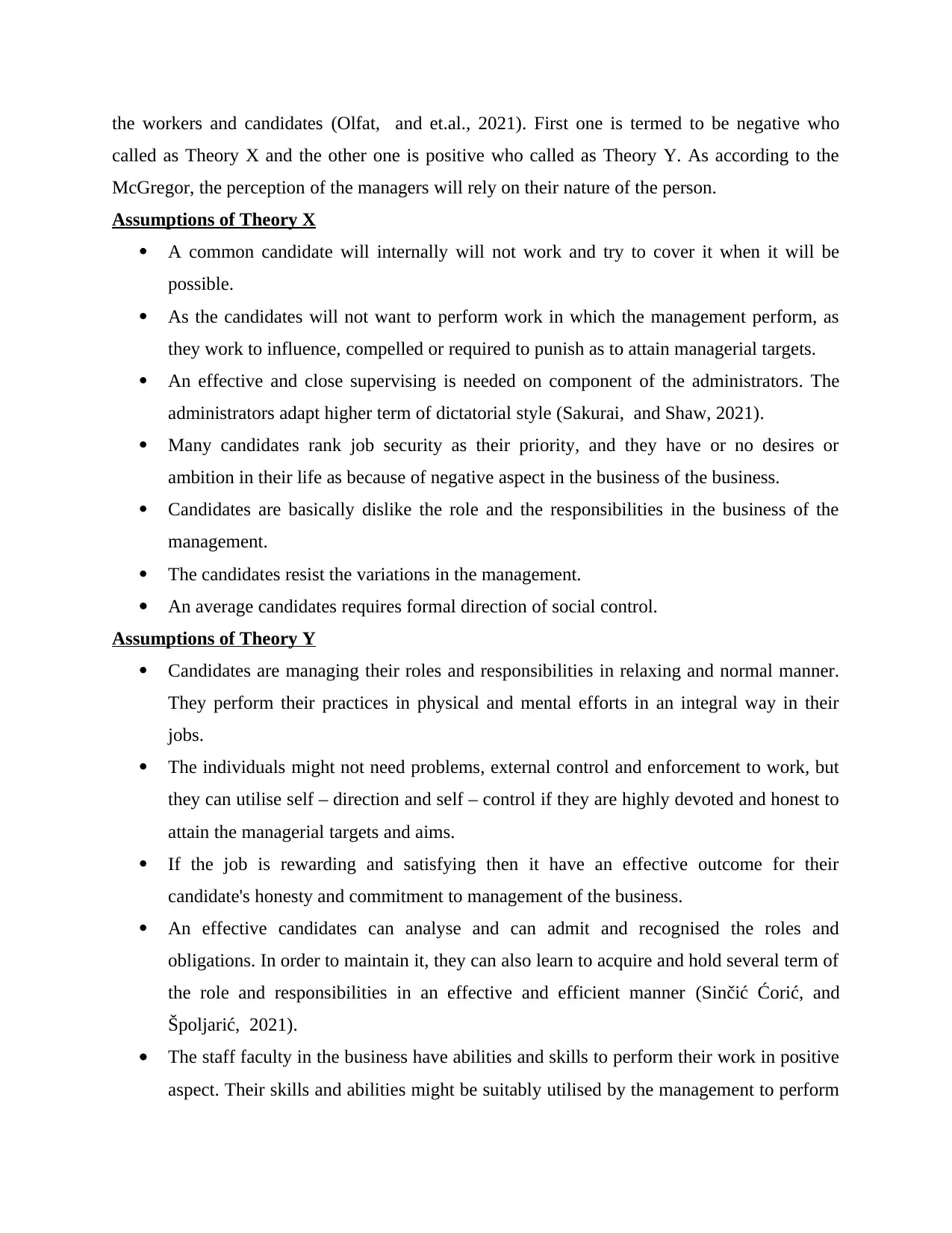
the workers and candidates (Olfat, and et.al., 2021). First one is termed to be negative who
called as Theory X and the other one is positive who called as Theory Y. As according to the
McGregor, the perception of the managers will rely on their nature of the person.
Assumptions of Theory X
A common candidate will internally will not work and try to cover it when it will be
possible.
As the candidates will not want to perform work in which the management perform, as
they work to influence, compelled or required to punish as to attain managerial targets.
An effective and close supervising is needed on component of the administrators. The
administrators adapt higher term of dictatorial style (Sakurai, and Shaw, 2021).
Many candidates rank job security as their priority, and they have or no desires or
ambition in their life as because of negative aspect in the business of the business.
Candidates are basically dislike the role and the responsibilities in the business of the
management.
The candidates resist the variations in the management.
An average candidates requires formal direction of social control.
Assumptions of Theory Y
Candidates are managing their roles and responsibilities in relaxing and normal manner.
They perform their practices in physical and mental efforts in an integral way in their
jobs.
The individuals might not need problems, external control and enforcement to work, but
they can utilise self – direction and self – control if they are highly devoted and honest to
attain the managerial targets and aims.
If the job is rewarding and satisfying then it have an effective outcome for their
candidate's honesty and commitment to management of the business.
An effective candidates can analyse and can admit and recognised the roles and
obligations. In order to maintain it, they can also learn to acquire and hold several term of
the role and responsibilities in an effective and efficient manner (Sinčić Ćorić, and
Špoljarić, 2021).
The staff faculty in the business have abilities and skills to perform their work in positive
aspect. Their skills and abilities might be suitably utilised by the management to perform
called as Theory X and the other one is positive who called as Theory Y. As according to the
McGregor, the perception of the managers will rely on their nature of the person.
Assumptions of Theory X
A common candidate will internally will not work and try to cover it when it will be
possible.
As the candidates will not want to perform work in which the management perform, as
they work to influence, compelled or required to punish as to attain managerial targets.
An effective and close supervising is needed on component of the administrators. The
administrators adapt higher term of dictatorial style (Sakurai, and Shaw, 2021).
Many candidates rank job security as their priority, and they have or no desires or
ambition in their life as because of negative aspect in the business of the business.
Candidates are basically dislike the role and the responsibilities in the business of the
management.
The candidates resist the variations in the management.
An average candidates requires formal direction of social control.
Assumptions of Theory Y
Candidates are managing their roles and responsibilities in relaxing and normal manner.
They perform their practices in physical and mental efforts in an integral way in their
jobs.
The individuals might not need problems, external control and enforcement to work, but
they can utilise self – direction and self – control if they are highly devoted and honest to
attain the managerial targets and aims.
If the job is rewarding and satisfying then it have an effective outcome for their
candidate's honesty and commitment to management of the business.
An effective candidates can analyse and can admit and recognised the roles and
obligations. In order to maintain it, they can also learn to acquire and hold several term of
the role and responsibilities in an effective and efficient manner (Sinčić Ćorić, and
Špoljarić, 2021).
The staff faculty in the business have abilities and skills to perform their work in positive
aspect. Their skills and abilities might be suitably utilised by the management to perform
⊘ This is a preview!⊘
Do you want full access?
Subscribe today to unlock all pages.

Trusted by 1+ million students worldwide
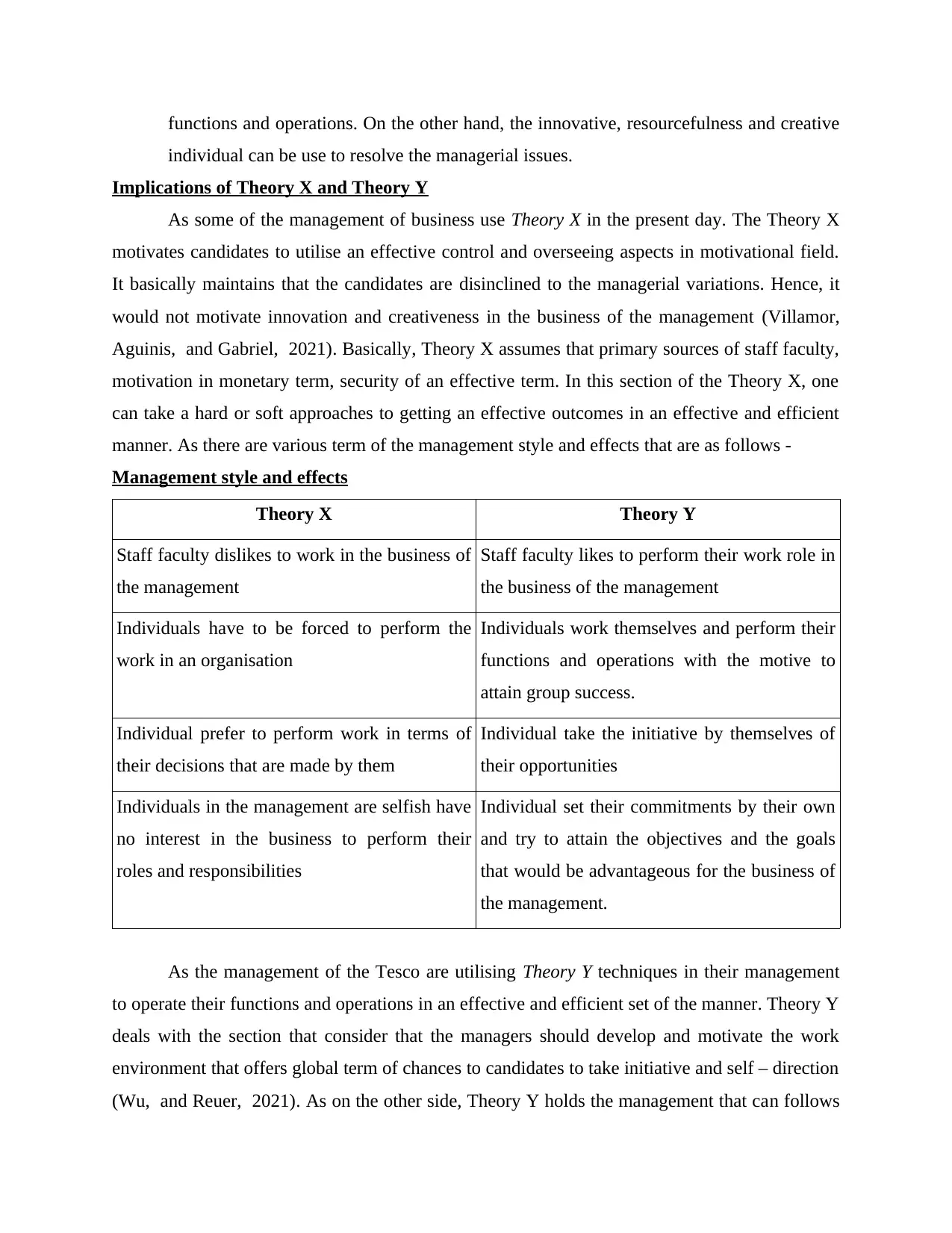
functions and operations. On the other hand, the innovative, resourcefulness and creative
individual can be use to resolve the managerial issues.
Implications of Theory X and Theory Y
As some of the management of business use Theory X in the present day. The Theory X
motivates candidates to utilise an effective control and overseeing aspects in motivational field.
It basically maintains that the candidates are disinclined to the managerial variations. Hence, it
would not motivate innovation and creativeness in the business of the management (Villamor,
Aguinis, and Gabriel, 2021). Basically, Theory X assumes that primary sources of staff faculty,
motivation in monetary term, security of an effective term. In this section of the Theory X, one
can take a hard or soft approaches to getting an effective outcomes in an effective and efficient
manner. As there are various term of the management style and effects that are as follows -
Management style and effects
Theory X Theory Y
Staff faculty dislikes to work in the business of
the management
Staff faculty likes to perform their work role in
the business of the management
Individuals have to be forced to perform the
work in an organisation
Individuals work themselves and perform their
functions and operations with the motive to
attain group success.
Individual prefer to perform work in terms of
their decisions that are made by them
Individual take the initiative by themselves of
their opportunities
Individuals in the management are selfish have
no interest in the business to perform their
roles and responsibilities
Individual set their commitments by their own
and try to attain the objectives and the goals
that would be advantageous for the business of
the management.
As the management of the Tesco are utilising Theory Y techniques in their management
to operate their functions and operations in an effective and efficient set of the manner. Theory Y
deals with the section that consider that the managers should develop and motivate the work
environment that offers global term of chances to candidates to take initiative and self – direction
(Wu, and Reuer, 2021). As on the other side, Theory Y holds the management that can follows
individual can be use to resolve the managerial issues.
Implications of Theory X and Theory Y
As some of the management of business use Theory X in the present day. The Theory X
motivates candidates to utilise an effective control and overseeing aspects in motivational field.
It basically maintains that the candidates are disinclined to the managerial variations. Hence, it
would not motivate innovation and creativeness in the business of the management (Villamor,
Aguinis, and Gabriel, 2021). Basically, Theory X assumes that primary sources of staff faculty,
motivation in monetary term, security of an effective term. In this section of the Theory X, one
can take a hard or soft approaches to getting an effective outcomes in an effective and efficient
manner. As there are various term of the management style and effects that are as follows -
Management style and effects
Theory X Theory Y
Staff faculty dislikes to work in the business of
the management
Staff faculty likes to perform their work role in
the business of the management
Individuals have to be forced to perform the
work in an organisation
Individuals work themselves and perform their
functions and operations with the motive to
attain group success.
Individual prefer to perform work in terms of
their decisions that are made by them
Individual take the initiative by themselves of
their opportunities
Individuals in the management are selfish have
no interest in the business to perform their
roles and responsibilities
Individual set their commitments by their own
and try to attain the objectives and the goals
that would be advantageous for the business of
the management.
As the management of the Tesco are utilising Theory Y techniques in their management
to operate their functions and operations in an effective and efficient set of the manner. Theory Y
deals with the section that consider that the managers should develop and motivate the work
environment that offers global term of chances to candidates to take initiative and self – direction
(Wu, and Reuer, 2021). As on the other side, Theory Y holds the management that can follows
Paraphrase This Document
Need a fresh take? Get an instant paraphrase of this document with our AI Paraphraser
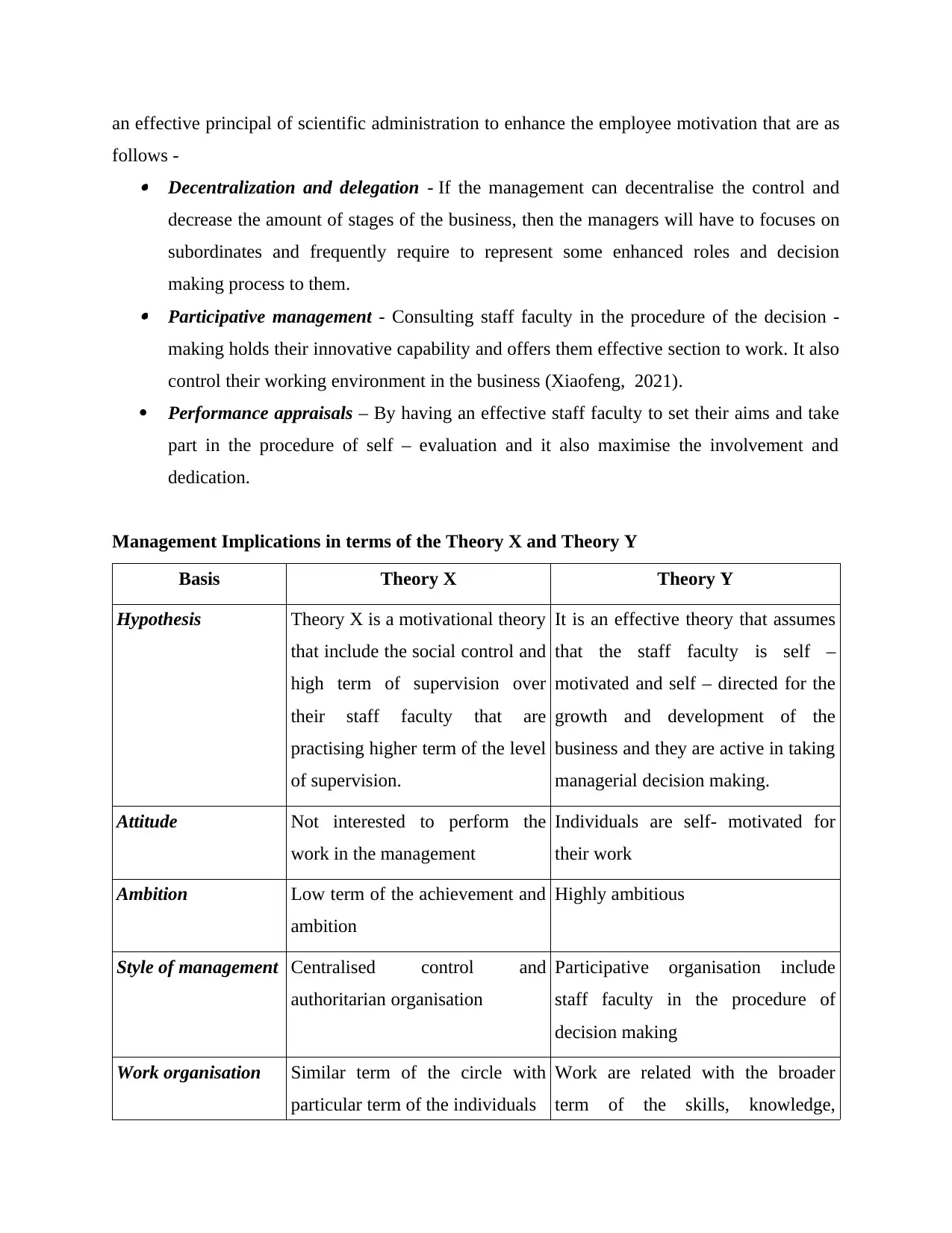
an effective principal of scientific administration to enhance the employee motivation that are as
follows - Decentralization and delegation - If the management can decentralise the control and
decrease the amount of stages of the business, then the managers will have to focuses on
subordinates and frequently require to represent some enhanced roles and decision
making process to them. Participative management - Consulting staff faculty in the procedure of the decision -
making holds their innovative capability and offers them effective section to work. It also
control their working environment in the business (Xiaofeng, 2021).
Performance appraisals – By having an effective staff faculty to set their aims and take
part in the procedure of self – evaluation and it also maximise the involvement and
dedication.
Management Implications in terms of the Theory X and Theory Y
Basis Theory X Theory Y
Hypothesis Theory X is a motivational theory
that include the social control and
high term of supervision over
their staff faculty that are
practising higher term of the level
of supervision.
It is an effective theory that assumes
that the staff faculty is self –
motivated and self – directed for the
growth and development of the
business and they are active in taking
managerial decision making.
Attitude Not interested to perform the
work in the management
Individuals are self- motivated for
their work
Ambition Low term of the achievement and
ambition
Highly ambitious
Style of management Centralised control and
authoritarian organisation
Participative organisation include
staff faculty in the procedure of
decision making
Work organisation Similar term of the circle with
particular term of the individuals
Work are related with the broader
term of the skills, knowledge,
follows - Decentralization and delegation - If the management can decentralise the control and
decrease the amount of stages of the business, then the managers will have to focuses on
subordinates and frequently require to represent some enhanced roles and decision
making process to them. Participative management - Consulting staff faculty in the procedure of the decision -
making holds their innovative capability and offers them effective section to work. It also
control their working environment in the business (Xiaofeng, 2021).
Performance appraisals – By having an effective staff faculty to set their aims and take
part in the procedure of self – evaluation and it also maximise the involvement and
dedication.
Management Implications in terms of the Theory X and Theory Y
Basis Theory X Theory Y
Hypothesis Theory X is a motivational theory
that include the social control and
high term of supervision over
their staff faculty that are
practising higher term of the level
of supervision.
It is an effective theory that assumes
that the staff faculty is self –
motivated and self – directed for the
growth and development of the
business and they are active in taking
managerial decision making.
Attitude Not interested to perform the
work in the management
Individuals are self- motivated for
their work
Ambition Low term of the achievement and
ambition
Highly ambitious
Style of management Centralised control and
authoritarian organisation
Participative organisation include
staff faculty in the procedure of
decision making
Work organisation Similar term of the circle with
particular term of the individuals
Work are related with the broader
term of the skills, knowledge,
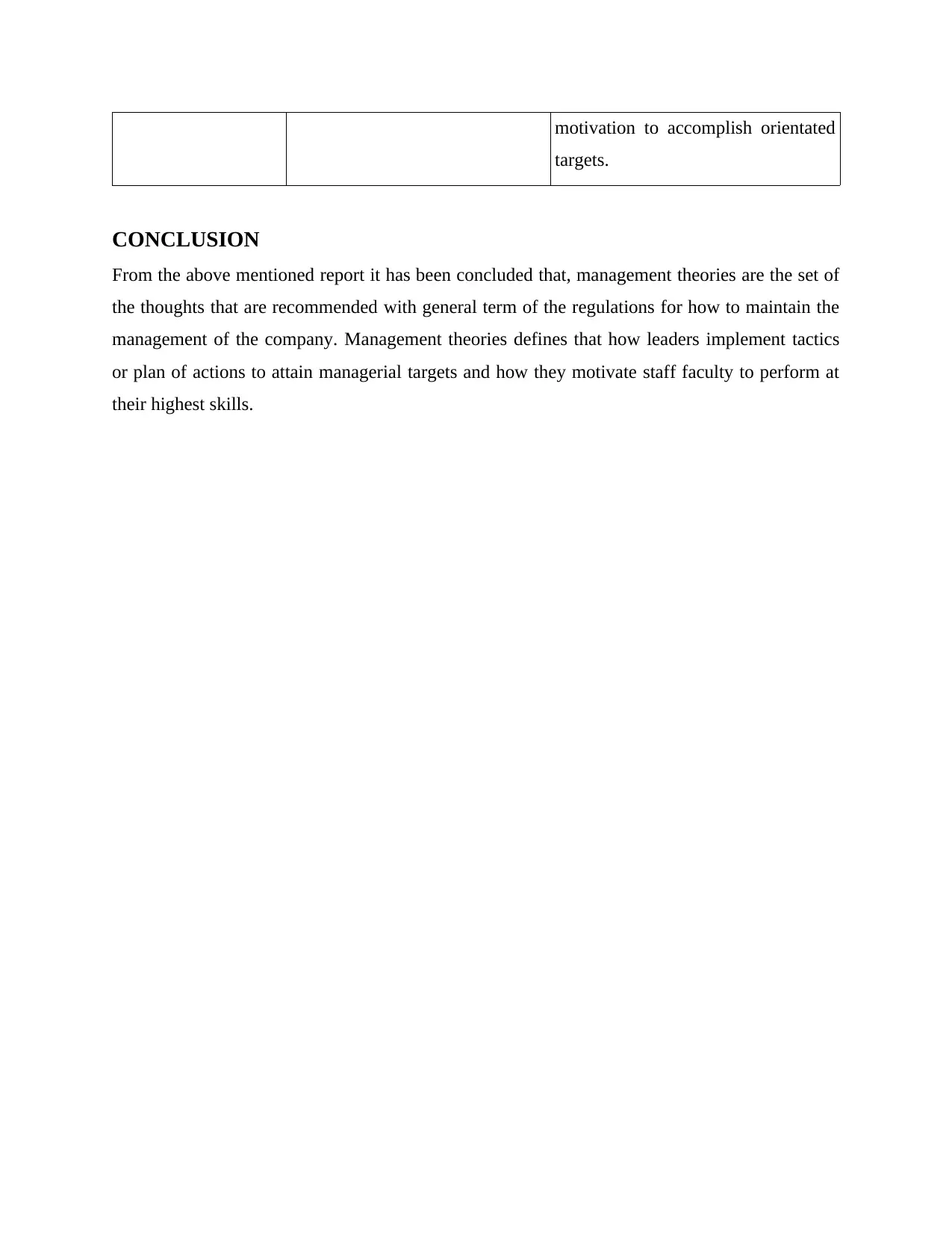
motivation to accomplish orientated
targets.
CONCLUSION
From the above mentioned report it has been concluded that, management theories are the set of
the thoughts that are recommended with general term of the regulations for how to maintain the
management of the company. Management theories defines that how leaders implement tactics
or plan of actions to attain managerial targets and how they motivate staff faculty to perform at
their highest skills.
targets.
CONCLUSION
From the above mentioned report it has been concluded that, management theories are the set of
the thoughts that are recommended with general term of the regulations for how to maintain the
management of the company. Management theories defines that how leaders implement tactics
or plan of actions to attain managerial targets and how they motivate staff faculty to perform at
their highest skills.
⊘ This is a preview!⊘
Do you want full access?
Subscribe today to unlock all pages.

Trusted by 1+ million students worldwide
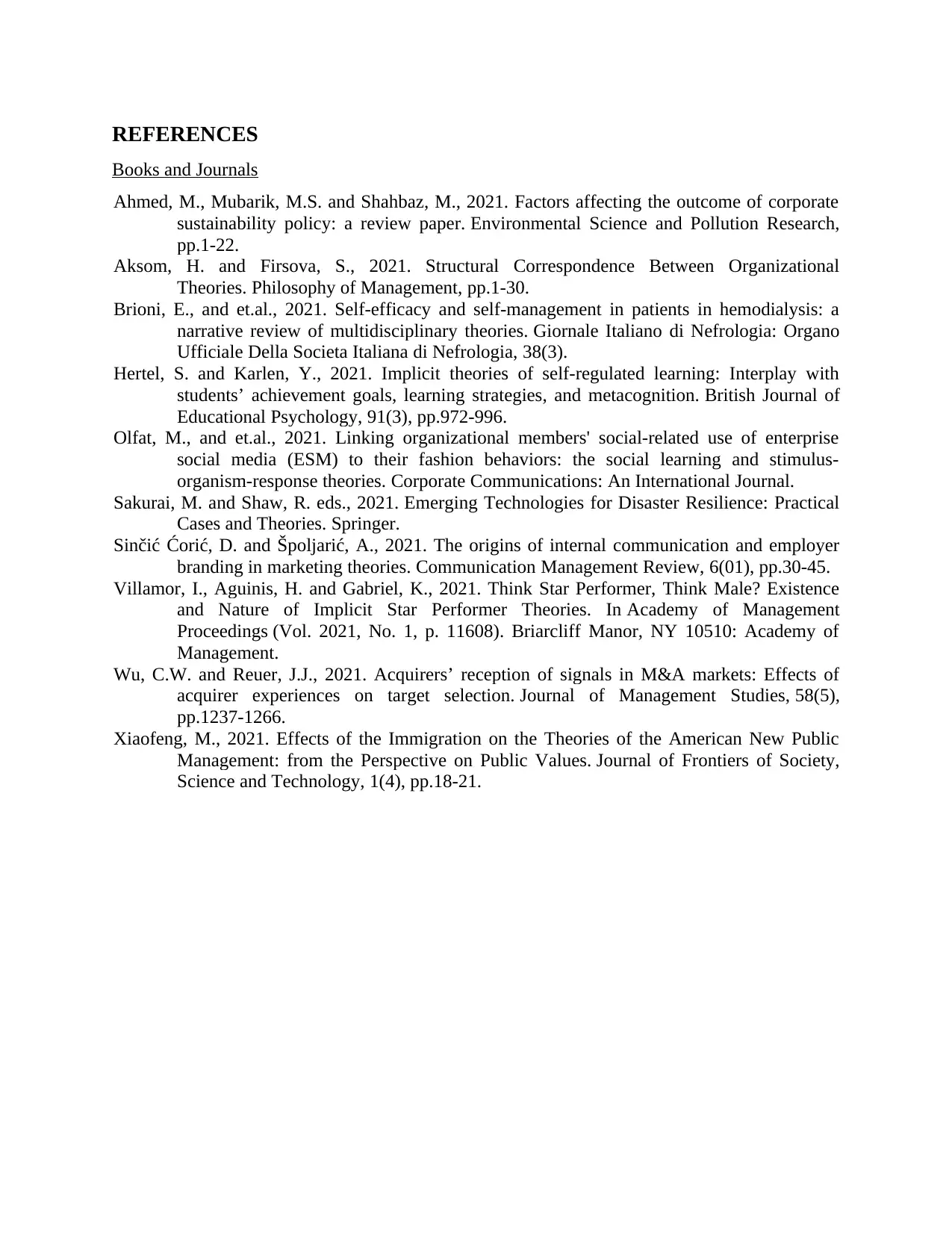
REFERENCES
Books and Journals
Ahmed, M., Mubarik, M.S. and Shahbaz, M., 2021. Factors affecting the outcome of corporate
sustainability policy: a review paper. Environmental Science and Pollution Research,
pp.1-22.
Aksom, H. and Firsova, S., 2021. Structural Correspondence Between Organizational
Theories. Philosophy of Management, pp.1-30.
Brioni, E., and et.al., 2021. Self-efficacy and self-management in patients in hemodialysis: a
narrative review of multidisciplinary theories. Giornale Italiano di Nefrologia: Organo
Ufficiale Della Societa Italiana di Nefrologia, 38(3).
Hertel, S. and Karlen, Y., 2021. Implicit theories of self‐regulated learning: Interplay with
students’ achievement goals, learning strategies, and metacognition. British Journal of
Educational Psychology, 91(3), pp.972-996.
Olfat, M., and et.al., 2021. Linking organizational members' social-related use of enterprise
social media (ESM) to their fashion behaviors: the social learning and stimulus-
organism-response theories. Corporate Communications: An International Journal.
Sakurai, M. and Shaw, R. eds., 2021. Emerging Technologies for Disaster Resilience: Practical
Cases and Theories. Springer.
Sinčić Ćorić, D. and Špoljarić, A., 2021. The origins of internal communication and employer
branding in marketing theories. Communication Management Review, 6(01), pp.30-45.
Villamor, I., Aguinis, H. and Gabriel, K., 2021. Think Star Performer, Think Male? Existence
and Nature of Implicit Star Performer Theories. In Academy of Management
Proceedings (Vol. 2021, No. 1, p. 11608). Briarcliff Manor, NY 10510: Academy of
Management.
Wu, C.W. and Reuer, J.J., 2021. Acquirers’ reception of signals in M&A markets: Effects of
acquirer experiences on target selection. Journal of Management Studies, 58(5),
pp.1237-1266.
Xiaofeng, M., 2021. Effects of the Immigration on the Theories of the American New Public
Management: from the Perspective on Public Values. Journal of Frontiers of Society,
Science and Technology, 1(4), pp.18-21.
Books and Journals
Ahmed, M., Mubarik, M.S. and Shahbaz, M., 2021. Factors affecting the outcome of corporate
sustainability policy: a review paper. Environmental Science and Pollution Research,
pp.1-22.
Aksom, H. and Firsova, S., 2021. Structural Correspondence Between Organizational
Theories. Philosophy of Management, pp.1-30.
Brioni, E., and et.al., 2021. Self-efficacy and self-management in patients in hemodialysis: a
narrative review of multidisciplinary theories. Giornale Italiano di Nefrologia: Organo
Ufficiale Della Societa Italiana di Nefrologia, 38(3).
Hertel, S. and Karlen, Y., 2021. Implicit theories of self‐regulated learning: Interplay with
students’ achievement goals, learning strategies, and metacognition. British Journal of
Educational Psychology, 91(3), pp.972-996.
Olfat, M., and et.al., 2021. Linking organizational members' social-related use of enterprise
social media (ESM) to their fashion behaviors: the social learning and stimulus-
organism-response theories. Corporate Communications: An International Journal.
Sakurai, M. and Shaw, R. eds., 2021. Emerging Technologies for Disaster Resilience: Practical
Cases and Theories. Springer.
Sinčić Ćorić, D. and Špoljarić, A., 2021. The origins of internal communication and employer
branding in marketing theories. Communication Management Review, 6(01), pp.30-45.
Villamor, I., Aguinis, H. and Gabriel, K., 2021. Think Star Performer, Think Male? Existence
and Nature of Implicit Star Performer Theories. In Academy of Management
Proceedings (Vol. 2021, No. 1, p. 11608). Briarcliff Manor, NY 10510: Academy of
Management.
Wu, C.W. and Reuer, J.J., 2021. Acquirers’ reception of signals in M&A markets: Effects of
acquirer experiences on target selection. Journal of Management Studies, 58(5),
pp.1237-1266.
Xiaofeng, M., 2021. Effects of the Immigration on the Theories of the American New Public
Management: from the Perspective on Public Values. Journal of Frontiers of Society,
Science and Technology, 1(4), pp.18-21.
1 out of 10
Related Documents
Your All-in-One AI-Powered Toolkit for Academic Success.
+13062052269
info@desklib.com
Available 24*7 on WhatsApp / Email
![[object Object]](/_next/static/media/star-bottom.7253800d.svg)
Unlock your academic potential
Copyright © 2020–2025 A2Z Services. All Rights Reserved. Developed and managed by ZUCOL.



